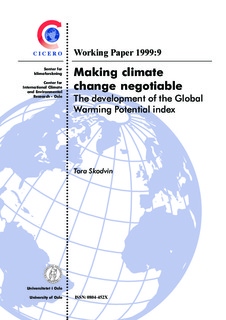| dc.description.abstract | One important contribution from science to environmental negotiations is the provision of scientific models, methods and concepts that may serve as decision-making tools and that hence may assist policy-makers in developing adequate solutions to environmental problems. In the context of climate change, the Global Warming Potential index has served a significant role in the process of making climate change negotiable. The Global Warming Potential index, which is a methodology for comparing the climate effect of a set of greenhouse gases and for transforming their emissions into a common measure, currently constitutes the foundation for implementation mechanisms adopted in the Kyoto Protocol, such as emissions trading, joint implementation and the clean development mechanism.
The topic of this trial lecture is the development of the Global Warming Potential index, the GWP index, and the political role of this methodology in the development of the climate regime. The history of the GWP index, the political context within which this methodology was first introduced and the political role this methodology has acquired is an interesting case of science–policy interaction which is illustrative of the mechanisms at work in such processes and the possible implications they may have both for the scientific and the political process.
After an introductory note, in which I introduce you to some of the essential characteristics of the problem of a human induced climate change and the political conditions that led to a strong political demand for the GWP methodology, I will discuss the more general notion of solution design models in negotiations, and requirements to their adequacy. In the third part of the presentation I will discuss the GWP index in more detail, and focus particularly on some of the more problematic aspects and shortcomings associated with this methodology. In the fourth part of the lecture, I will return to the political process on climate change, and discuss some implications for the adequacy of the solution design model adopted in the climate regime. In the last and final part of the lecture, then, I will draw some conclusions from this discussion.
The lecture is based on previous and current research at my own institute, CICERO, and secondary literature, in particular work by Simon Shackley and Brian Wynne as well as Steven Smith and Tom Wigley. | nb_NO |
